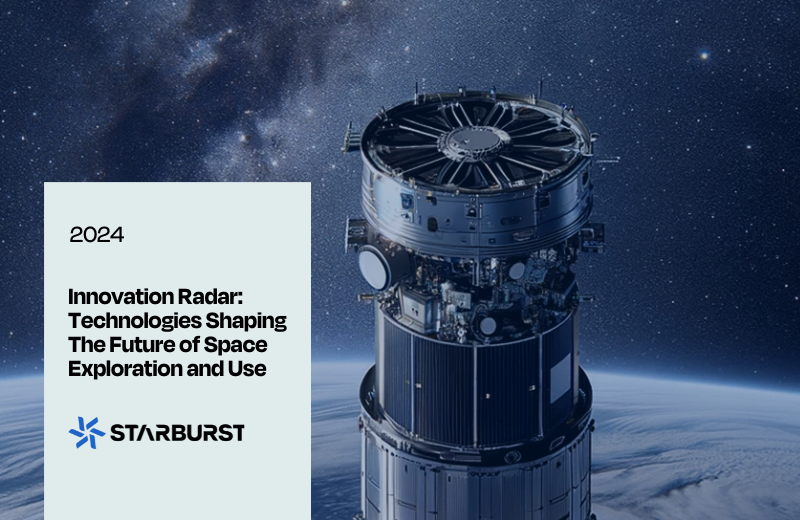The “Innovation Radar”: A Tool for Distinguishing Valuable Signals from Mere Noise in The NewSpace Industry

The NewSpace economy represents a radical shift from traditional space activities, driven by the convergence of innovation, entrepreneurship, and private investment. NewSpace companies leverage cutting-edge technologies and novel business models to lower costs and increase access to space. This democratization of space has paved the way for a host of new players, from startups developing small satellites to established tech giants launching ambitious space missions.
In this dynamic sector, the “Innovation Radar”, an analysis report conducted by Starburst Aerospace that offers an in-depth study of the innovations and technologies that have the potential to shape the future of space exploration and use, acts as an interesting tool for distinguishing valuable signals from mere noise. This framework offers a clear and comprehensive understanding of the space industry by focusing on two crucial notions: technology and market. It evaluates advancements and opportunities using criteria such as customer readiness levels (CRL), investment flows, and competition intensity, helping to identify genuinely promising innovations.
Twenty years ago, the Innovation Radar would have featured fewer bubbles, highlighting how dynamic innovation has progressed beyond mere promises into tangible advancements. This demonstrates that the NewSpace sector is moving in the right direction with a range of promising innovations.
The Innovation Radar highlights two primary drivers of this innovation:
- Military/Dual-Use Potential: Technologies with military or dual-use applications have strong potential to attract both public and private capital, demonstrating substantial development prospects.
- Private Market Dynamics: Commercial markets of critical size, such as direct-to-device services or ground services as a station, can quickly attract investment and stimulate rapid innovation.
While growth, such as the transformation of infrastructure and services in space, is underway, it remains somewhat incremental, indicating that while progress is being made, there is still ample room for growth and acceleration in the sector.
In this highly competitive sector, going from an incredibly innovative solution to a widespread product or service is a challenging journey. For some applications to scale effectively, three primary barriers must be addressed: technological, financial, and regulatory.
Technological barriers involve ensuring that innovations are mature and reliable enough for widespread adoption. Financial barriers pertain to securing the necessary investment to support large-scale deployment. Regulatory barriers, often the most complex, involve navigating local and international regulations that can impede progress. These barriers provide a framework for understanding which innovations are accessible and have the potential to scale.
For example, the development of direct-to-device technology is nearly complete from a technical standpoint. However, it faces significant regulatory challenges — local regulations need to be clarified, and the technology must prove its appeal to the mass market. While almost all indicators are positive, the market is not yet fully ready for widespread adoption. This underscores the crucial need to overcome regulatory hurdles and convince consumers of the added value of this technological innovation.
By addressing these barriers, stakeholders and innovators can better identify and support innovations that have the potential to transform the NewSpace industry.
Such a sector presents unique opportunities and challenges for space stakeholders across the market, each with their own perspectives and priorities:
- For Space Agencies, innovation is deeply embedded within their operations. However, their primary challenge lies in scaling these innovations beyond the traditional space ecosystem to other industries. Agencies need to bridge the gap between advanced research and large-scale practical applications to fully realize their potential.
- For Investors, long-term commitment is essential, as the return on investment often spans many years. Despite the extended timelines, the benefits are significant and have the potential for impact on a global scale. Investors should focus on structural applications, such as in-orbit mobility, which is a crucial node in the NewSpace infrastructure.
- For Industrial Players, the abundance of innovations requires a new approach. Industries must make strategic choices, form partnerships, and transform their working methods to avoid the risk of innovation dilution. Developing a collaborative ecosystem is vital for harnessing the full potential of technological advancements.
- For Startups, while ambitious projects, like asteroid mining, capture the imagination, they may not attract immediate investment. Startups should adopt a dual-strategy approach, generating short-term revenue streams to sustain operations while pursuing long-term visionary goals. The sheer volume of concurrent innovations is exciting, but the industry must be cautious as many business models are still unproven.
The NewSpace sector is vibrant and full of potential, yet it requires careful navigation and strategic collaboration among all stakeholders to transform innovations into scalable and sustainable business models.
Curious to discover our insights and explore these exciting trends in more detail?

